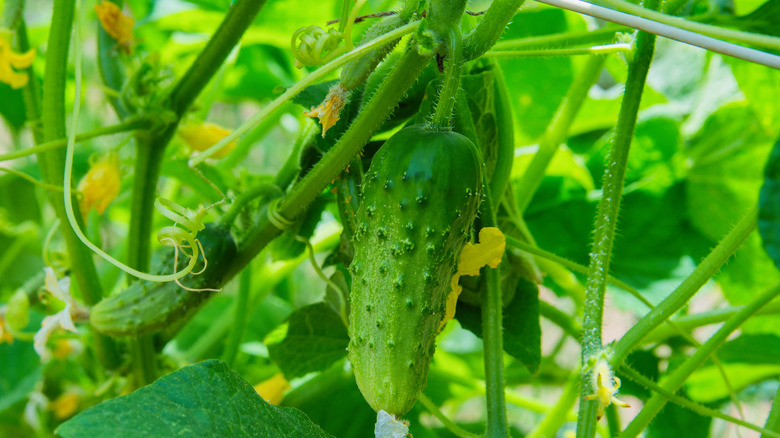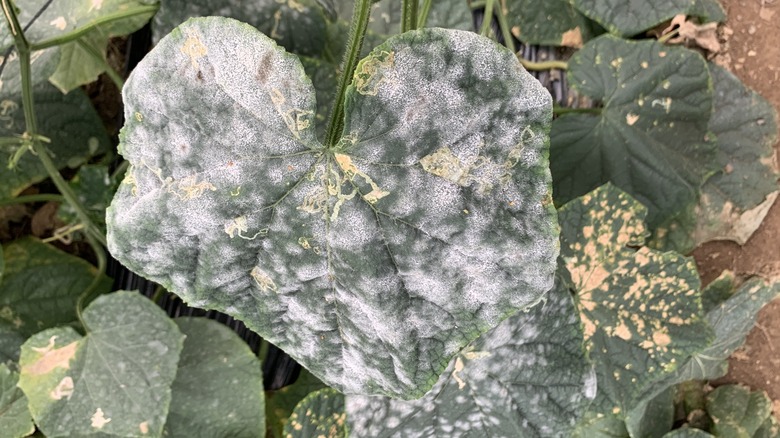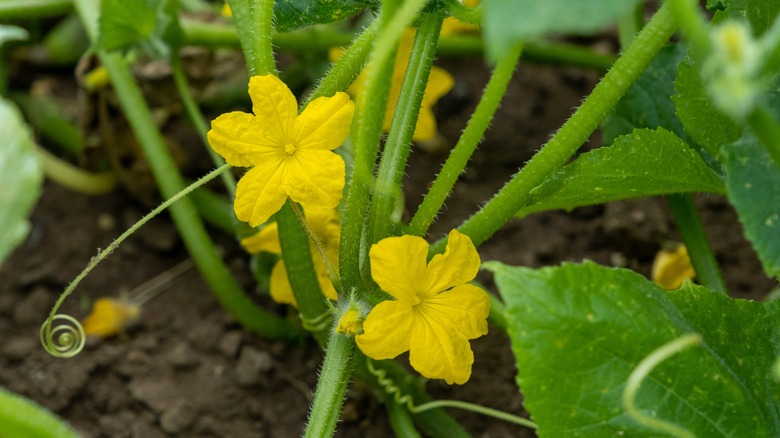What's The Best Way To Treat Powdery Mildew On Cucumbers?
In the world of botany, the Cucurbitaceae family is made up of squash, melons, and cucumbers, which are collectively known as cucurbits. In the cucumber category (Cucumis sativus), you'll find a range of varieties split further into three subcategories: long green slicing cucumbers that grow along vines, long green slicing cucumbers that grow on compact bushes, and pickling cucumbers, explains the University of Illinois Extension.
Depending on the space in your garden or the type of cucumber you wish to grow, you may end up planting a variety that has been bred to be highly resistant to common diseases. These include Fanfare, Marketmore 76, Salad Bush, and Carolina. But what if you're keen on growing a Tasty Jade Japanese-style cucumber or a Taurus? Purdue University warns that these cultivars are among the most prone to a fungal infection called powdery mildew.
Left untreated, this disease can spread from a plant's leaves to its stems and petioles. Leaves will deteriorate prematurely, and both the quality and quantity of your cucumbers will go down (via NC State Extension). Purdue University maintains that proper variety selection is an important factor in preventing and managing powdery mildew outbreaks, but it's not a guarantee that your cucurbit plants won't succumb to the disease if left to grow in conditions that encourage the fungus to thrive.
How to tell if your cucumbers have powdery mildew
Mildew issues in the garden are the result of fungal pathogens gone wild. To correctly identify the type of mildew adversely affecting your cucumbers, it's important to note the difference between powdery mildew (pictured above) and another very similar-sounding fungal disease called downy mildew; each requires specific and distinct tactics to control. According to Penn State Extension, downy mildew has a bluish tint on the underside of a plant's leaves along with yellow spots on the tops of the leaves.
Here, we're focusing on powdery mildew. As its name suggests, this type of infection looks like white powder sprinkled across the cucumber plant's leaves. Podosphaera xanthii and Erysiphe cichoracearum are the main culprits, two fungi that are happy as little clams when average temperatures hover around 68 to 80 degrees Fahrenheit and humidity stays in the medium to high range. Thick, densely packed foliage and low light conditions spur them on even more, per NC State Extension. Keep in mind that even if humidity levels are as low as 50%, infections can still develop.
A plant under duress from powdery mildew may yield cucumbers with speckled skin. Plantura Magazine suggests that they may still be safe to eat if the mildew is only on the leaves, but they're not likely to taste very good. Once mildew has spread to the fruit itself, it's best to avoid consuming it. Look for speckles or any sort of discoloration.
How to get rid of powdery mildew on cucumbers
You'll know a healthy cucumber plant by its bright yellow flowers and evenly green foliage. Of course, disease prevention is the most effective way to keep them in this state, and when it comes to powdery mildew, that primarily means proper spacing between plantings to ensure sufficient airflow as they grow. Old leaves are most likely to be the starting point for an infection, per The Connecticut Agriculture Experiment Station, so it's a good idea to remove them. This will help increase the circulation of fresh air as well.
Don't get too discouraged by the onset of that ugly white powdery mildew; if it happens, there are commercial fungicides available to home growers. NC State Extension recommends products containing copper or chlorothalonil as active ingredients. These are the only fungicides that will be reliably effective. The site specifically recommends a product called Daconil, which can be found in commercial garden centers and stores like Home Depot.
If you prefer to lean toward natural products for your garden, look to the Organic Materials Review Institute (OMRI) for guidance. This organization verifies and provides information on which products are acceptable for safe and healthy gardening. NC State Extension notes that organic growers will need to rely on fixed copper formulations in order to stay in line with OMRI guidelines.



